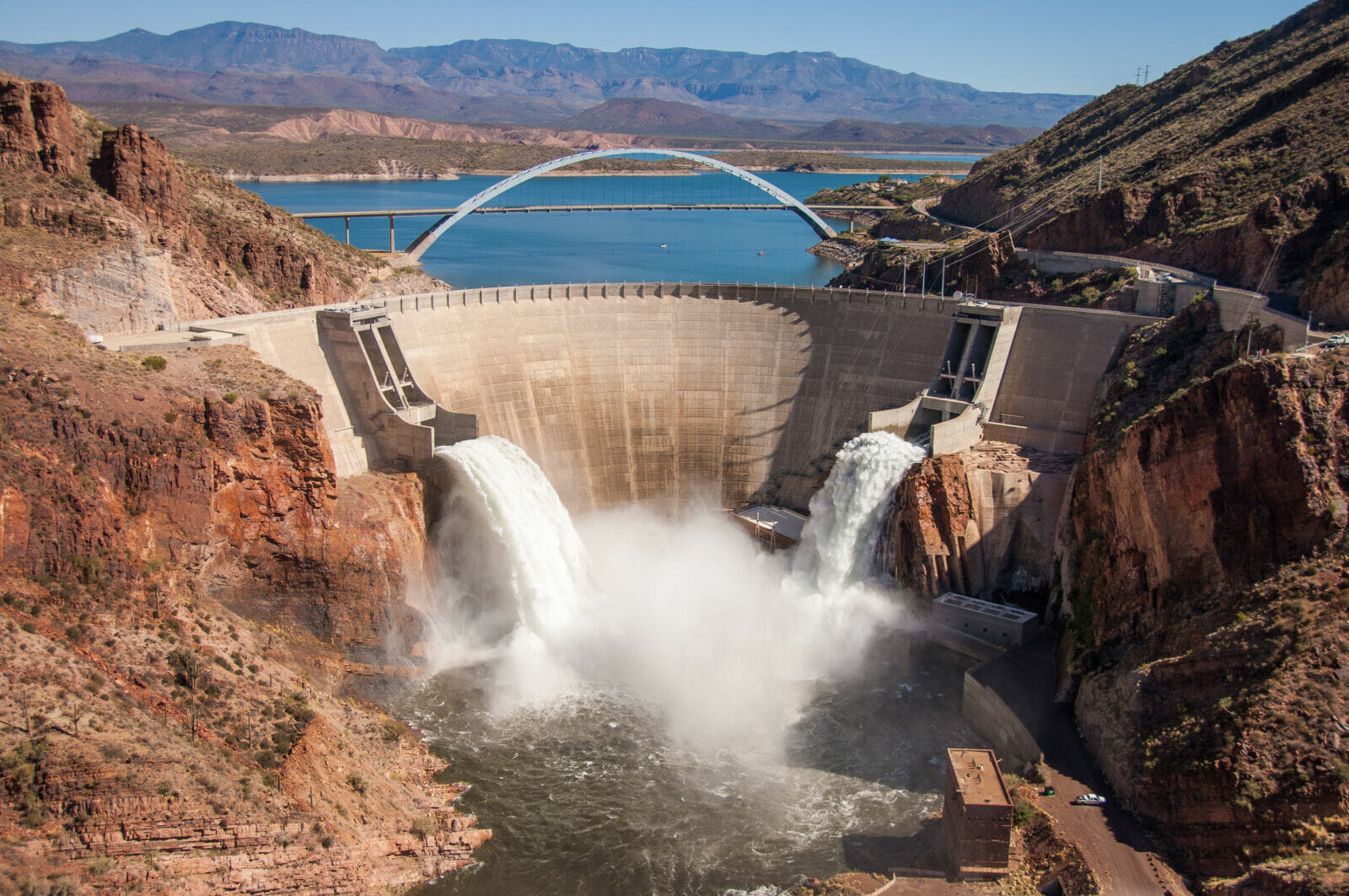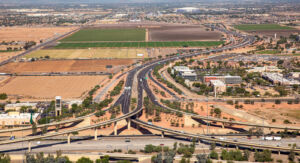Describing Arizona’s recent economic development hot streak as anything but banner years for the state would be — to put it mildly — a vast understatement. The Taiwan Semiconductor Manufacturing Company (TSMC) is building a $12 billion chip plant in Phoenix and its supply chain is following suit; companies in the electric vehicle (EV) business such as ElectraMeccanica and KORE Power are adding to the sector’s growing footprint in the Valley; and the Grand Canyon State continues to be a data center destination, attracting industry giants such as Apple, Microsoft and Meta.
It’s not just companies moving to Arizona either. A U.S. Census Bureau data release on March 24, 2022, shows that Maricopa County increased its population by 58,246 people last year — the largest increase in the nation by a comfortable margin.
READ ALSO: Meta Mesa Data Center will expand to more than 2.5M SF
While growth is a boon for the state, there is an understandable concern about the most precious resource in any desert: water. Luckily, elected officials in Arizona have been working with the federal government, other states, tribal leadership and the business community to ensure that the lifeblood of the region is properly managed.
“We use less water today in Arizona than we did in 1957,” explains Governor Doug Ducey at a Valley Partnership breakfast on Feb. 25, 2022. “We are the best in the United States at water. Here we are in the fastest growing metropolitan area in the country, in the middle of a desert. And everyone that is moving here is planting a front lawn and digging a pool.”
Still, with the ever-increasing popularity of Arizona as a desert oasis, is enough being done to balance growth while protecting the state’s water assets?
Tier 1 shortage
Worries about the availability of water are not unfounded. According to the Arizona Department of Water Resources’ website, the state has been in some stage of drought since 1994. Moreover, the U.S. Bureau of Reclamation published a study in Aug. 2021 which effectively declared a Tier 1 shortage for the Colorado River in 2022. As a result, Arizona will lose 512,000 acre-feet out of 2.8 million in Colorado River water supply.
“The Bureau of Reclamation’s study looks two years into the future,” says Tom Buschatzke, director of the Arizona Department of Water Resources, at a Valley Partnership breakfast on Nov. 19, 2021. “It projected that in July of 2023, Lake Mead would fall below an elevation of 1,030 feet. At 1,020 feet, there’s about 5.4 million acre-feet left in the lake before it’s completely empty. That’s about half of what we would use in a year at full use with all the losses that are attached to deliveries and evaporation.”
Bending that projection curve so Lake Mead stays above the critical elevation of 1,020 feet will require continued coordination between Arizona, Nevada and California on conservation efforts.
“We do have a corpus of a plan put together to conserve between the three states another 500,000 acre-feet a year for five years starting in 2022,” Buschatzke continues. “It isn’t going to be an easy task. But we have cobbled together for 2022 and 2023 — at least on paper — 500,000 acre-feet of water in each of those two years. We’ve had nontribal entities, tribal entities, farmers, cities — you name it — that have come forward to work with us.”
Prudent planning
Signed into law in April 2019, the Drought Contingency Plan Authorization Act codifies a set of agreements to share resources and mitigate the impacts of shortages. Some water users have committed to leave extra water in Lake Mead and share water with those most severely affected. Since Arizona has junior priority on the Colorado River, it has the most to lose — namely, its supply is cut first and by most during shortages.
“When we signed the Drought Contingency Plan in 2019, it incentivized additional stores in Lake Mead,” Buschatzke continues. “We have 65 feet of water artificially in Lake Mead from the actions in Arizona, California, Nevada and Mexico. Collectively, we would be in a Tier 2 shortage — and would have been for several years — had that plan not been put into place, along with all the conservation efforts that led up to it.”
Building upon that plan, the Arizona Legislature established the Drought Mitigation Fund in 2021 with an initial $160 million investment for large, statewide water augmentation projects. At a Valley Partnership breakfast on Nov. 19, 2021, House Speaker Rusty Bowers explains that, “This money is focused on bringing water from outside of Arizona to Arizona and making sure there is at least some funding from the legislature and taxpayers to augment and increase our capacity, not just conserve.”
During his final State of the State address, Ducey announced his plan to invest an additional $1 billion to secure Arizona’s water future.
“The last real water policy that was done before this administration was the 1980 Groundwater Management Act with [former Arizona governor] Bruce Babbitt,” Ducey says. “And even with the Drought Contingency Plan, we knew that there was more to be done. Our relationship with Mexico is at an all-time high, and with some of these technologies coming together to provide different potential generational projects, that would assure our next 100 years of water; it’s time to take $1 billion in our budget, in addition to maximizing our rainy-day fund.”
Part of that $1 billion, according to a summary of draft legislation issued by Ducey’s office on Feb. 25, would create a new statewide entity called the Arizona Water Authority. It would have the power to purchase and sell water on behalf of the state, identify long-term water sources and oversee water storage credits. The Arizona Water Authority would also administer the Water Supply Development Revolving Fund and the Long-term Water Augmentation Fund.
“I’ve had the pleasure of being able to stand on the shoulders of some real giants that have come before me,” Ducey says, “people like [former senator] Carl Hayden, Bruce Babbitt, [former congressman] John Rhodes and most recently, [former senator] Jon Kyl. No leader will see the completion of any water project in their term. You have to think in decades or half centuries.”
Assured water supplies
One of the reasons water stewardship is at the forefront is because of Arizona’s popularity as a destination for businesses and people. A virtuous cycle is in motion where companies are choosing the Grand Canyon State for a litany of reasons, including an educated workforce, favorable location for logistics and business-friendly policies. This spurs demand for housing and recreation opportunities, which increases the capacity and attractiveness of Arizona for further investment.
That said, growth requires having water available now and into the future to be sustainable, even if more water was used 65 years ago than today.
“The reason we don’t use as much water now is because of the transition away from agriculture. Most businesses use way less water, but there’s a misconception that growth is harming water in the state,” explains Cheryl Lombard, president and CEO of Valley Partnership. “The development community has a part to play in addressing these issues.”
Lombard notes that Valley Partnership has worked closely with the City of Phoenix to help address its conservation needs, going so far as to support water rates increases to help build infrastructure. “That way,” she says, “we can move water around the city to enable things like TSMC to happen in the West Valley and promote growth north of the [Loop] 101.”
Since the Valley is in a designated active management area under the 1980 Groundwater Management Act, projects must demonstrate a 100-year assured water supply. The Arizona Department of Water Resources’ website notes that the program is designed to sustain the state’s economic health by preserving groundwater resources and promoting long-term water supply planning.
While Arizona has been addressing responsible growth for decades, Lombard explains that there is more to be done. Valley Partnership advocates for a raft of water policies, including supporting responsible in-state water transfers and the ability for the Colorado River Indian Tribes to transfer water supplies throughout Arizona.
Water-conscious development
Having the proper amount of water over 100 years is important for any project, but especially for residential communities. Take the Douglas Ranch master-planned community in Buckeye, where the Howard Hughes Corporation estimates that 300,000 residents will live in 100,000 homes upon full buildout.
Heath Melton, president of the Phoenix region for the Howard Hughes Corporation, says that the company is working to make sure that water resources are being properly maintained. “We’ll work from both the top-down approach through state and regional engagement, and then from the bottom up through building and community measures,” he says. “We will utilize groundwater from the Hassayampa River Basin aquifer directly beneath the property, one of the most plentiful aquifers in the region.”
The company will also build a water reclamation plant that will provide a source to recharge groundwater and irrigate common areas. Moreover, Melton notes that as a master-plan developer, the Howard Hughes Corporation also has more control over the design standards of the community.
“We have the ability to put out guidelines on what’s utilized within the homes such as state-of-the-art, low-flow water fixtures as well as the landscape material that’s placed on the lots,” he says. “That includes moving from traditional spray irrigation to drip irrigation, which minimizes water use from a consumption and evaporation standpoint.”
Lombard concludes that unity is key for managing Arizona’s most precious resource. “Everyone cares about water now,” she says. “We’re trying to work with others in the business community to emphasize the need to work on statewide solutions. We shouldn’t divide the state into rural and urban — we’re all in this together and can all work on solutions together.”




